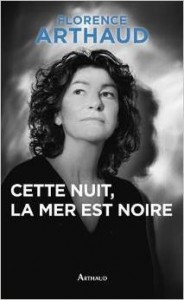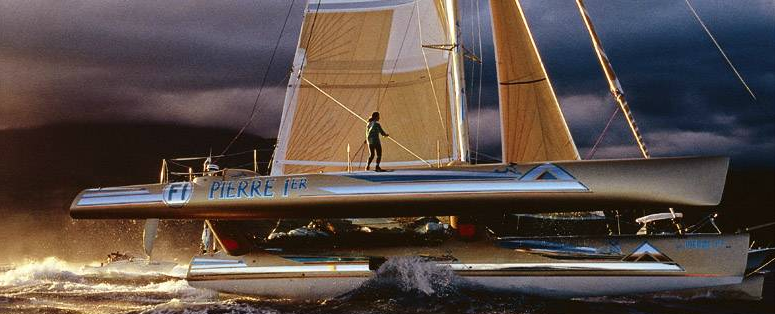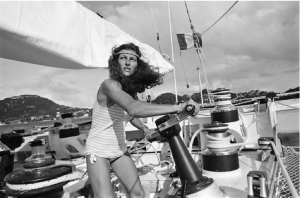French yachting star Florence Arthaud, who broke into solo ocean racing in the 1980’s and became a sailing legend by winning the 1990 Route dy Rhum, died recently in a collision between two helicopters in Argentina during the filming of a wilderness survival TV series. She was one of three French sporting stars who died in the crash, which killed all ten people in both aircraft.
This tragic accident was seen as another national disaster in France, after the Charlie Hebdo killings. Arthaud was twice the age of her rivals on this ill-fated trip, but achieved national fame for her skill and daring as a single-handed sailor in the 1980’s and early 90’s. (This was well before the internet age, which is why she is barely known to English-speaking sailors and why I have researched and written this memorial to her remarkable life.)
She was born in 1957 to a father who was a successful publisher. She began sailing with her him and her brother in the Mediterranean at an early age: “The first time I went sailing it was with my father, destination Marseille ; I was six and a half. I learned sailing in the Mediterranean.” This would have been the summer when Eric Tabarly galvanized French sailors with his victory over Francis Chichester in the 1964 OSTAR.
In a remarkable coincidence, the Arthaud publishing house won the rights to publish the first book by Tabarly, “Victoire en Solitaire,” and after him the work of long-distance cruiser Bernard Moitessier. This must have made a powerful impression on Florence–meeting the young naval officer that the whole country was talking about.
She grew up loving speed under sail or on the highway. At the age of 17, Florence was involved in a car crash which left her in a coma and paralyzed. She also had serious injuries to her face, and spent six months in hospital. It took two years before she recovered completely, but was left with visible scarring. Nonetheless, the next year, 1975, she made her first Atlantic crossing at the age of 18.
In the era of old-school sailors like Eric Tabarly and Olivier de Kersauson, she began crewing on the first generation of French racing multihulls that were still in the experimental stage. She entered the first Route du Rhum in 1978 on a shoestring budget with a yacht named X.Périmental. This was a heavy-displacement aluminum Frioul 38 designed to fit the 1976 OSTAR’s Jester class. Arthaud reached Guadeloupe in eleventh place.
However, being the first woman to compete in the Rhum didn’t help her find sponsors until she connected with a wine company and was able to enter the 69′ slender aluminum monohull Kriter V in the 1981 Twostar. She finished sixth with François Boucher as co-skipper.
With Biotherm as her next sponsor, a state-of-the-art 60′ trimaran was built for her in 1981, again in aluminum. She entered the 1982 Route du Rhum but had to return to the start to repair early damage, struggled on with more broken rigging, and finished way down the rankings. In the 1983 Transat en Double (France-Bermuda-France) she finished eighth with Patrick Maurel in 26 days. In 1984, a huge fleet of 92 yachts entered the 1984 OSTAR and Florence, now 26, was one of four women, but was slowed by breakages and abandoned in the Azores.
In the 1986 Route du Rhum, she witnessed one of the early tragedies in French open racing when she diverted to the position of the wing-masted maxi-catamaran Royale, finding it capsized and skipper Loic Caradec lost. (He was perfectly aware of the risk, but it shocked the French public and a size limit of 60′ was imposed on the 1990 race and not removed until 2008).
Her new sponsor was the property developer Pierre 1er (Pierre Premier) who built one of the first modern ORMA-Class 60′ trimarans, designed by the young team VPLP. She joined 23 other multihulls at the start of the 1990 Rhum in St Malo, facing experienced solo sailors like Bourgnon, Peyron, Poupon and de Broc. Despite being deprived of any means of communication, it was Florence who was first to cross the finish line. She also set a record for a solo crossing of the Atlantic, with a time of 14 days, 10 hours. She was the first woman to win an ocean race, so the newspapers called her « la petite fiancée de l’Atlantique » best translated as the “Little Sweetheart of the Atlantic.” The French sports magazine L’Equipe named her Champion of Champions for 1990.
The next summer, she broke the open record for a solo crossing of the North Atlantic (held by Bruno Peyron) by two days with a time of 9 days, 21 hours. Thus she held both open records for Atlantic crossings (NY-Lizard and Ouessant-Caribbean) at the same time, which must have really frustrated her rivals. “After my victory in the Rhum, it seems that many French wanted to marry me,” she says in his biography published in 2008. “The poor souls, if they knew, if they only knew me!”
She never again reached that peak, for Arthaud was a colorful character with a strong personality and stronger language–she was dropped by her sponsor shortly after this victory, capsized her boat, and had to be content with rides on smaller boats in coastal races. Pierre 1er went on to more success after it was bought by American record breaker Steve Fossett and re-named Lakota. ( I saw it in La Rochelle in 2013 looking as sleek as ever.)
After the birth of her daughter Marie in 1993, Arthaud became a symbol of women’s rights after conquering a male-dominated sport. “I searched for a long time for sponsors who invested in sustainable development or urgent humanitarian causes. In the 1990s nobody was interested in that. I wanted to name my boat SOS, beat records and draw attention to these issues but I didn’t succeed.”
“I had my daughter at 36 years. Before, I did not have a woman’s life. I had a disorderly life and adventurous. I burnt the candle at both ends,” she told one lifestyle reporter. Arthaud raced occasionally as crew: in 1997 she crewed for Bruno Peyron when he set a new Los Angeles-Hawaii “Transpac” record with the 86-ft maxi cat Commodore Explorer that had gone around the world in 79 days.
French Women like Isabelle Autissier, Catherine Chabaud, Karine Fauconnier and Anne Casseneuve did follow in her wake and build their own careers, but more than one observer noted that Florence partied as hard as she raced, which worked against her as time went by. So she often found a place in long double-handed events as the crew who attracted more attention than the male skipper! (English woman Ellen MacArthur won the Open 60 class of the 2002 Rhum, but the trimarans won the overall prize as it had done in every race.)
In 2005, Flo married Eric Charpentier, but not unexpectedly, the marriage quickly began to founder. She carried on crewing until 2009, when she published her autobiography, “A Wind of Freedom,” preface by Olivier de Kersauson, in which she recounted her life, her dreams, her victories; but also the addictions to alcohol and tobacco. \
In 2010, twenty years after her epic Rhum triumph, she hoped the anniversary would allow her to find a sponsor. That was the year the Rhum organizers abandoned the 80′ size limit, so she wanted to participate on a 100′ trimaran. “I was a little disgusted–I have not managed to get the boat, they preferred to give it to a man (Sidney Gavignet). I quit!” she said, and finally turned her back on her brilliant racing career.
But she was back on the water on her own 33′ yacht and in 2011, came close to dying again after falling overboard north of Corsica in the Med. A small wave hit the boat and knocked her overboard while she was taking a toilet break without her usual harness, she explained. “I quite simply fell into the water while preparing to take a pee,” the 54-year-old told BFM television.
She would have drowned from this casual mistake, just like Eric Tabarly in 1998, but she was carrying two pieces of modern technology that saved her: an LED headlamp and a waterproof smart phone. She managed to raise the alarm by calling her mother in Paris. Two hours later, a helicopter rescued her. She had bought the phone the previous week!
In 2010, she lost her license for drunk driving. She was planning to launch an international women-only sailing event in Marseille, where she lived when not in Paris. “The sea is a great school. I need to share everything the sea has given me.” she wrote.
Her last appearance at a sailing event was at the 10th Route du Rhum in November 2014, when the organizers brought all the winners together in front of a large admiring audience.
Ed. Note: For more of Peter’s maritime musings, visit his blog.


